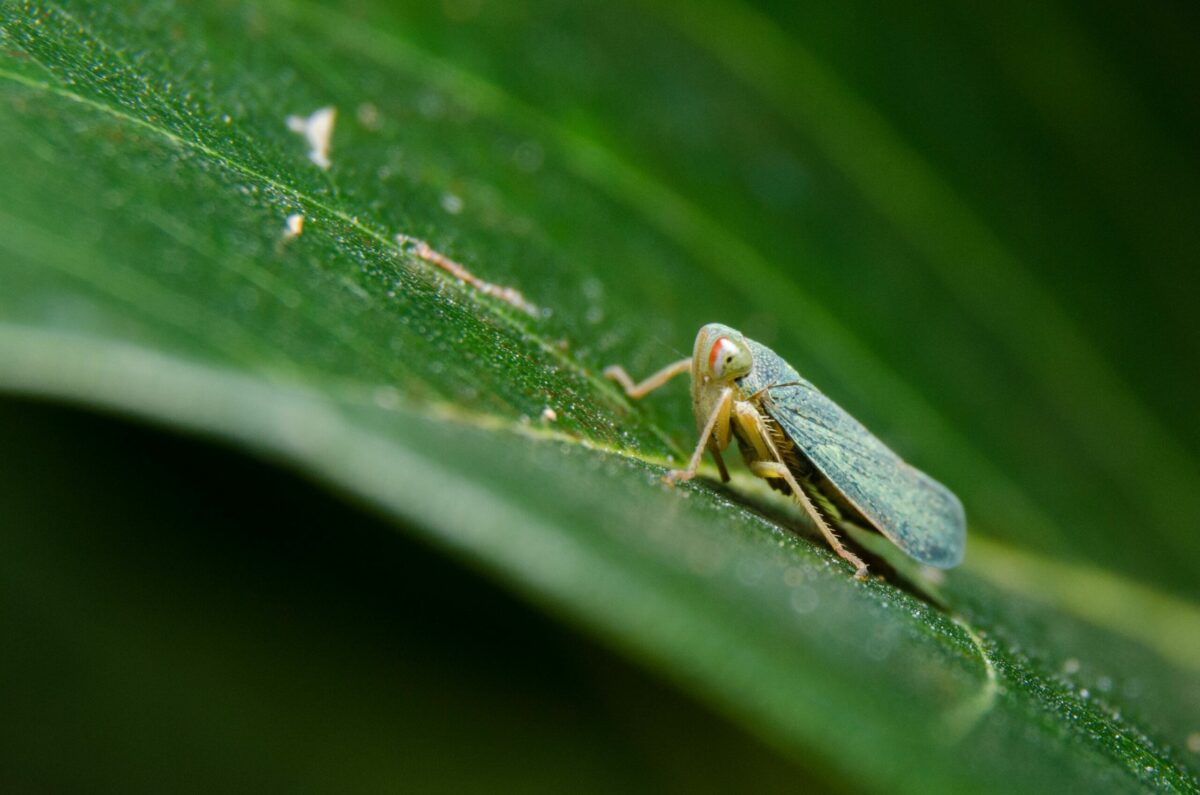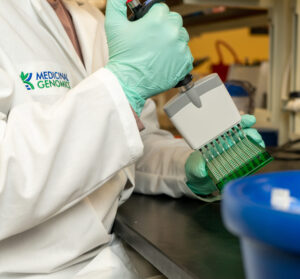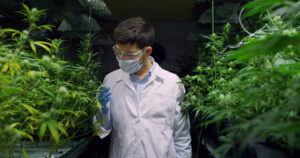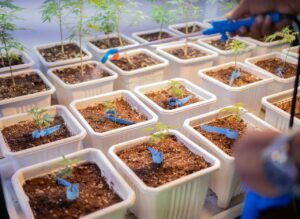There are still a lot of unknowns when it comes to hop latent viroid (HLVd), including how the pathogen spreads. New research indicates that leafhoppers, which are known vectors for beet curly top virus and lettuce chlorosis virus, may also have the ability to spread HLVd.
The Medicinal Genomics team has been working with Collin Palmer to study HLVd infection in cannabis. Collin is housing HLVd-infected plants at his facility, and he recently spotted leafhoppers on them. He suspected they could be capable of spreading the viroid, so he captured a few leafhoppers and brought them to our lab for testing. It turns out that his instincts were spot on.
Can Leafhoppers Test Positive HLVd?
To start, we placed two leafhoppers that were sourced from an HLVd-infected plant (UK Cheese) into a magnetic leaf lysis solution and boiled them for 8 minutes at 92C.
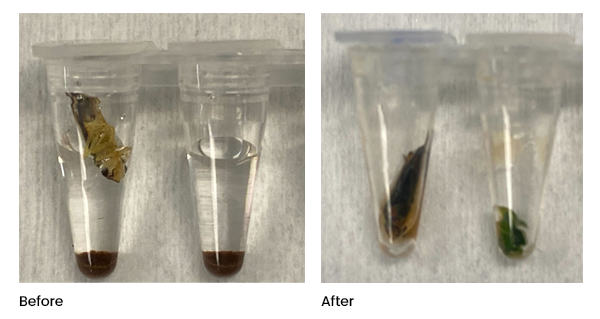
After the boil, we removed the liquid and used a magnetic bead based DNA purification process to isolate the DNA and RNA. Lastly, we used the PathoSEEK Hop Latent Viroid Detection Assay v2 to test for HLVd. The assay detected HLVd RNA was present in both leafhoppers. In fact, the amount of viroid detected in the leafhoppers was greater than we saw in certain plant tissues from the same plant!
| Sample | HLVd CT | Cannabis Control CT |
| Leafhopper 1 | 27.34 | 35.59 |
| Leafhopper 2 | 35.17 | 24.50 |
| UK-Cheese Top 1 | 34.64 | 24.50 |
| UK-Cheese Top 2 | 34.63 | 25.31 |
| UK-Cheese Top 3 | 33.28 | 25.50 |
| UK-Cheese Top 5 | 28.78 | 25.46 |
| UK-Cheese Top 6 | 28.46 | 24.56 |
| UK-Cheese Top 7 | 34.55 | 24.43 |
| UK-Cheese Top 8 | 33.07 | 24.89 |
| UK-Cheese Top 9 | 34.27 | 24.32 |
| UK-Cheese Petiole 1 | 35.11 | 24.82 |
| UK-Cheese Petiole 2 | 33.76 | 25.27 |
| UK-Cheese Petiole 3 | 32.17 | 24.75 |
| UK-Cheese Petiole 4 | 28.05 | 26.54 |
| UK-Cheese Petiole 5 | 15.72 | 32.10 |
| UK-Cheese Bottom | 21.53 | 27.10 |
| Positive Control | 13.57 | ND |
| NTC | ND | ND |
Can Leafhopperd Transmit HLVd?
Encouraged by these results we want to test whether the UK Cheese leafhoppers could infect a clean leaf.
We collected 11 more leafhoppers from the infected UK-Cheese cultivar and split them into two groups. We placed 5 leafhoppers in a bag with the HLVd-infected UK-Cheese leaves to serve as a control. The other 6 leafhoppers were placed in a bag with HLVd-negative leaves from the Gary Payton cultivar.
We left them at room temperature for 20 hours so the leafhoppers could feed on the leaves. Then we purified DNA and RNA from the leafhoppers and the leaves using the same magnetic bead based boil prep, and tested them for HLVd.


The results showed that 9 of the 11 leafhoppers tested positive for HLVd. Additionally, the leaf from the previously negative Gary Payton cultivar tested positive for HLVd!
| Sample | HLVd CT | Cannabis Control CT |
| UK-Cheese Leafhopper 1 | 35.28 | 35.04 |
| UK-Cheese Leafhopper 2 | 34.83 | 32.82 |
| UK-Cheese Leafhopper 3 | 28.44 | 33.16 |
| UK-Cheese Leafhopper 4 | ND | 33.04 |
| UK-Cheese Leafhopper 5 | 34.52 | 34.22 |
| UK-Cheese Leaf 1 | 17.64 | 24.17 |
| UK-Cheese Leaf 2 | 16.99 | 22.27 |
| UK-Cheese Petiole | 20.36 | 23.26 |
| Gary Payton Leafhopper 1 | ND | 35.03 |
| Gary Payton Leafhopper 2 | 30.62 | 32.22 |
| Gary Payton Leafhopper 3 | 35.35 | 32.89 |
| Gary Payton Leafhopper 4 | 34.91 | 31.53 |
| Gary Payton Leafhopper 5 | 35.13 | 33.49 |
| Gary Payton Leafhopper 6 | 26.26 | 31.59 |
| Gary Payton Leaf | 28.90 | 24.64 |
| Gary Payton Petiole | 24.64 | 25.06 |
| Positive Control | 17.45 | ND |
| NTC | 45.10 | ND |
Conclusions
This preliminary study suggests that leafhoppers have the potential to spread HLVd to healthy plants. However, more controlled experiments with better plant isolation protocols are needed to confirm these results. Additionally, the speciation of the leafhoppers in this experiment have not been confirmed genetically.
Having said that, and considering many growers are understandably concerned about controlling HLVd, it is reasonable to assume that leafhoppers are a potential vector for HLVd transmission.
What Does This Mean for the HLVd Origin Story?
HLVd’s zoonotic leap from hops to cannabis was widely assumed to be the result of attempts to cross cannabis and hop plants. This assumption is based on the fact that the only known method of transmission for HLVd is via mechanical infection. This most commonly occurs when growers do not sterilize pruning scissors between plants.
In fact, some researchers even tried to graft cannabis flowers onto hop plants with the goal of producing a cannabinoid-rich plant that can evade detection. Given the fact that HLVd is widespread amongst hops, it is certainly possible that the plants used in those experiments were infected with the viroid.
If indeed leafhoppers can spread HLVd, perhaps that was the vector that brought HLVd from an infected hop plant to a new host.

